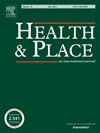Neighborhood socioeconomic disadvantage and travel time to diabetes prevention programs in Maryland
IF 4.1
2区 医学
Q1 PUBLIC, ENVIRONMENTAL & OCCUPATIONAL HEALTH
引用次数: 0
Abstract
Background
Transportation issues are a significant barrier for accessing the National Diabetes Prevention Program (NDPP), which remains an effective intervention to prevent type 2 diabetes. Although the link between neighborhood socioeconomic disadvantage and access to health care resources has been widely studied, its impact on travel time and access to NDPP has been underexplored.
Methods
Medicaid and private claims data for 2019 from the Maryland Medical Care Data Base were linked to 2019 Social Deprivation Index (SDI) data to measure neighborhood socioeconomic disadvantage. Google Distance Matrix Application Programming Interface key for Google Maps Platform was used to generate travel time estimates for enrollees diagnosed with prediabetes. Then adjusted generalized linear regression models using SDI quintiles and the interaction of SDI quintile and race and ethnicity were fitted to predict driving and public transit travel time to the nearest NDPP.
Findings
Enrollees living in neighborhoods with the highest SDI scores (most disadvantaged) had significantly shorter driving and public transit travel time to the nearest NDPP compared to enrollees living in neighborhoods with the lowest SDI scores (least disadvantaged). We found differences in the magnitude of shorter travel times across racial and ethnic groups and transportation mode.
Conclusion
Our findings fill a major gap in the literature on neighborhood socioeconomic disadvantage and travel time to NDPP. Findings highlight the role state policies may have had in expanding access to NDPP. More research is needed to examine strategies to address racial and ethnic disparities, and transportation needs to improve access to in-person NDPP.
马里兰州社区社会经济劣势和出行时间对糖尿病预防项目的影响
交通问题是进入国家糖尿病预防计划(NDPP)的一个重要障碍,NDPP仍然是预防2型糖尿病的有效干预措施。虽然社区社会经济劣势与获得卫生保健资源之间的联系已被广泛研究,但其对旅行时间和获得NDPP的影响尚未得到充分探讨。方法将马里兰州医疗保健数据库2019年的医疗补助和私人索赔数据与2019年社会剥夺指数(SDI)数据联系起来,以衡量社区的社会经济劣势。谷歌地图平台的距离矩阵应用程序编程接口键用于生成诊断为前驱糖尿病的参选者的旅行时间估计。然后利用SDI五分位数和SDI五分位数与种族和民族的相互作用拟合调整广义线性回归模型来预测到最近的NDPP的驾驶和公共交通出行时间。与居住在SDI得分最低的社区(最弱势)的参会者相比,居住在SDI得分最高的社区(最弱势)的参会者到最近的NDPP的驾驶和公共交通旅行时间显着缩短。我们发现,不同种族、不同民族和不同交通方式的人在缩短出行时间的程度上存在差异。结论本研究结果填补了邻域社会经济劣势与到达新城区出行时间研究的空白。调查结果强调了国家政策在扩大NDPP获取方面可能发挥的作用。需要更多的研究来检查解决种族和民族差异的战略,交通需要改善面对面的NDPP。
本文章由计算机程序翻译,如有差异,请以英文原文为准。
求助全文
约1分钟内获得全文
求助全文
来源期刊

Health & Place
PUBLIC, ENVIRONMENTAL & OCCUPATIONAL HEALTH-
CiteScore
7.70
自引率
6.20%
发文量
176
审稿时长
29 days
期刊介绍:
he journal is an interdisciplinary journal dedicated to the study of all aspects of health and health care in which place or location matters.
 求助内容:
求助内容: 应助结果提醒方式:
应助结果提醒方式:


